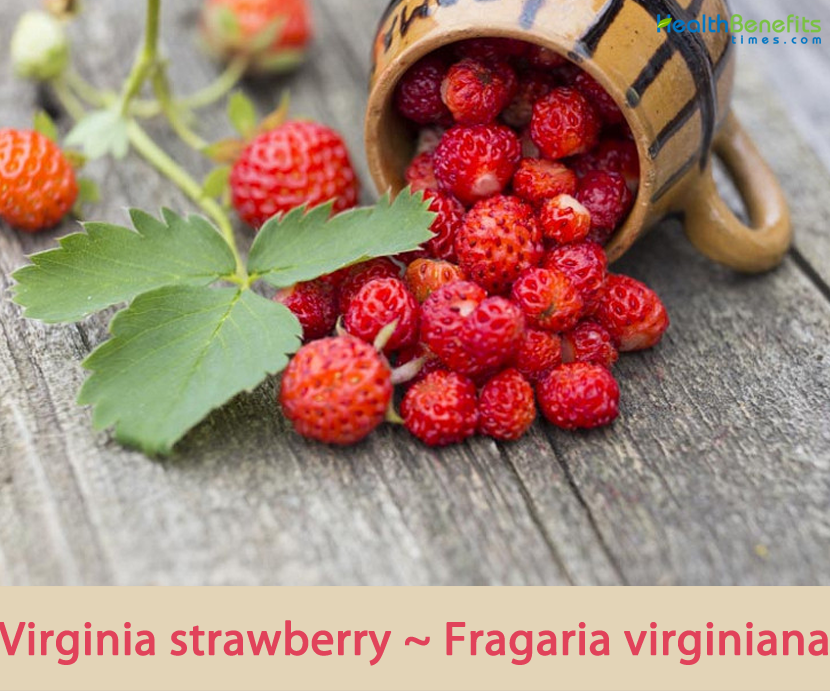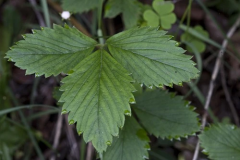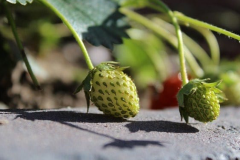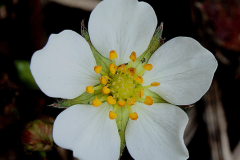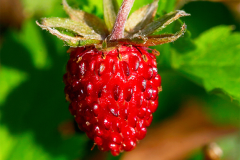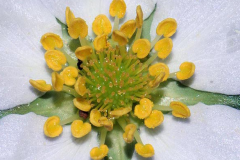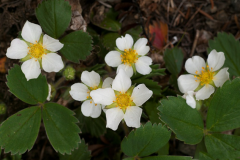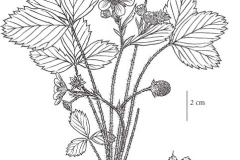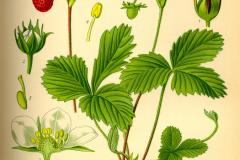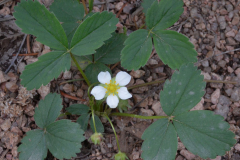| Virginia strawberry (Scarlet strawberry) Quick Facts | |
|---|---|
| Name: | Virginia strawberry (Scarlet strawberry) |
| Scientific Name: | Fragaria virginiana |
| Origin | United States and southern Canada |
| Colors | Yellowish green to reddish brown |
| Shapes | Fruits are up to ½ inches long and across, globoid or globoid-ovoid in shape, |
| Taste | Sweet, Sour |
| Health benefits | Support for diarrhea, irregular menses, gonorrhea, stomach and lung ailments, dysentery, cataract, anemia, gingivitis, toothache, scurvy, yellow teeth, asthma, wrinkles, rashes, bruises, gastritis and menopausal troubles |
| Name | Virginia strawberry |
|---|---|
| Scientific Name | Fragaria virginiana |
| Native | United States and southern Canada |
| Common Names | Mountain strawberry, Scarlet strawberry, Virginia strawberry, Wild strawberry, Common strawberry, Thick-leaved strawberry, Woods strawberry, Thick-leaved wild strawberry |
| Name in Other Languages | Arabic: Fara wlatan baraa (فر ولة برى), Frawlah barri, tut al’ard alfirjinia (توت الأرض الفرجيني) Bulgarian: Virdzhinska yagoda (Вирджинска ягода) Chinese: He wei zhou cao mei (和 威州草莓), Mei guo wei ji ni ya zhou cao mei (美国维吉尼亚州草莓), Wei ji ni ya zhou cao mei (维 吉 尼亚州草莓 ), Fú zhōu cǎoméi (弗州草莓) Cree: Ohtihmina Czech: Jahodník viržinský, Jahodka virgínska Danish: Havejordbaer, Skarlagen-Jordbær, Skovjordbær Dutch: Bosaardbeien, Virginia aardbei, Wilde bosaardbeien English: Mountain strawberry, Scarlet strawberry, Virginia strawberry, Wild strawberry, Common strawberry, Thick-leaved strawberry, Woods strawberry Estonian: Virgiinia maasikas Finnish: Virginianmansikka French: Fraisier des champs, Fraise écarlate, Fraisier de Virginie, Fraise des champs German: Scharlacherdbeere, Scharlach-Erdbeere, Virginiaerdbeere, Virginische Erdbeere Italian: Fragoloni Japanese: Furagaria viruginiana (フ ラガリア・ウィルギニアナ ), Bājiniaichigo (バージニアイチゴ) Latvian: Virdžīnijas zemene Norwegian: Virginiajordbær Persian: توتفرنگی ویرجینیایی Polish: Poziomka wirginijska Portuguese: Morango da América do Norte, morangueiro-da-virgínia Russian: Zemlyanika virginskaya (Земляника виргинская), zemlyanika virdzhinskaya (земляника вирджинская), Zemlyanika shtata Virdzhiniya (Земляника штата Вирджиния) Slovenian: Jahoda virgínska Spanish: Fresón Swedish: Scharlakanssmultron, Virginianmansikka Turkish: Virginya çileği, Yabani çilek Ukrainian: Sunytsi virhinsʹki (суниці віргінські) |
| Plant Growth Habit | Low-growing, ground-hugging, fast-spreading, herbaceous perennial (i.e. not woody) plant |
| Growing Climates | Moist to dry fields, roadsides, gravelly meadows, grassy open slopes, thickets, forest edges, open forests in the lowland to subalpine zones, woodland openings, prairies, limestone glades, roadsides, black soil prairies, hill prairies, bluegrass meadows, small meadows in wooded areas, open woodlands, woodland borders, savannas, limestone glades and areas along railroads |
| Soil | Prefers a fertile, well-drained, moisture retentive soil in a sunny position. Tolerates semi-shade though fruit production will be reduced when plants grow in such a position |
| Plant Size | Up to 100 mm (4 in) tall |
| Leaf | Leaves are green (sometimes bluish-green) on top and pale green underneath. Each mature leaflet can reach to about 7 cm (3 inches) long and 4 cm (1.5 inches) wide; however, they are generally smaller. |
| Flowering season | April to June |
| Flower | Flowers have a hairy stalk. There are 5 green pointed sepals placed alternate with the petals and alternating with the sepals are 5 green shorter bractlets. |
| Fruit Shape & Size | Achene-dotted ovoid fruits up to ½ inches long and across |
| Fruit Color | Yellowish green to reddish brown |
| Taste | Sweet, Sour |
| Plant Parts Used | Leaves, Fruit, Root |
| Propagation | Both sexually by seed, and asexually by runners (stolons) |
| Season | June to July |
Plant Description
Virginia strawberry is a low-growing, ground-hugging, fast-spreading, herbaceous perennial (i.e. not woody) plant rising from a fibrous, perennial root system. The plant normally grows up to 100 mm (4 in) tall but spreads indefinitely by runners (stolons) which root to form new plants as they sprawl along the ground, often forming large colonies over time. The plant is found growing in moist to dry fields, roadsides, gravelly meadows, grassy open slopes, thickets, forest edges, open forests in the lowland to subalpine zones, woodland openings, prairies, limestone glades, roadsides, black soil prairies, hill prairies, bluegrass meadows, small meadows in wooded areas, open woodlands, woodland borders, savannas, limestone glades and areas along railroads. It prefers a fertile, well-drained, moisture retentive soil in a sunny position. It tolerates semi-shade though fruit production will be reduced when plants grow in such a position.
Leaves
The plant typically consists of several trifoliate leaves at the tips of long hairy petioles. The leaves are green (sometimes bluish-green) on top and pale green underneath. Each mature leaflet can reach to about 7 cm (3 inches) long and 4 cm (1.5 inches) wide; however, they are generally smaller. The leaflets are oval shaped and have coarse teeth along the edge except near the bottom. The terminal tooth (at the very tip) is much smaller in size to the teeth on either side of it and does not extend beyond them. Stems are above ground runners (stolons) that root at tips from which a crown of leaves emerge.
Flowers
The inflorescence is a cluster of small flowers at the top of the flowering scape (an above ground extension of the root), usually held at leaf level or below. The wild strawberries have 5-parted 1/2-3/4 inch flowers with wide white rounded petals that have clawed bases. Plants can vary in having flowers that are functionally bisexual (perfect), functionally staminate (male) or functionally pistillate (female). Flowers have a hairy stalk. There are 5 green pointed sepals placed alternate with the petals and alternating with the sepals are 5 green shorter bractlets. All are slightly hairy. There are numerous stamens with yellow anthers surrounding a blunt central yellow-green receptacle composed of numerous carpels. Multiple small leaflet-like bracts are often present where the flower stalks diverge at the top of the stem. Flowering normally takes place in between April to June.
Fruits
Afterwards, the flowers are replaced by achene-dotted ovoid fruits (strawberries) when growing conditions are favorable, otherwise they abort. These fruits are up to ½ inches long and across. They are globoid or globoid-ovoid in shape, becoming bright red at maturity. Small seeds are scattered across the surface of these fruits in sunken pits. The persistent sepals and sepal-like bracts are appressed to the upper surface of these fruits. The fleshy interior of these fruits has a sweet-tart flavor and they are edible.
Botanically, the achenes are the true fruits and the red strawberries are actually false fruits (enlarged flower receptacles). Cultivated strawberries found in stores are hybrid crosses between F. virginiana (native to North America) and F. chiloensis (native to western coastal South America including Chile) which combine the excellent taste of the former with the larger fruit size of the latter. Virginia strawberries reproduce both sexually by seed, and asexually by runners (stolons).
Traditional Uses and benefits of Virginia strawberry
- The whole plant is antiseptic, astringent, emmenagogue, galactogogue and odontalgic.
- It has been used to regulate the menstrual cycle.
- Tea made from the leaves has been used as a nerve tonic and is slightly astringent.
- Poultice made from the dried powdered leaves mixed with oil has been used to treat open sores.
- A tea made from the roots is diuretic.
- It has been used in the treatment of diarrhea, irregular menses, gonorrhea, stomach and lung ailments.
- Tea from the wild strawberry’s dried leaves is used to treat dysentery.
- It keeps eye troubles at bay thus, guards the eyes from the harmful UV rays. It curbs Cataract.
- It curbs anemia and effectively cleans the blood.
- It is a good herbal remedy for dental troubles namely gingivitis, toothache, scurvy and yellow teeth.
- It combats ailments leading to respiratory discomforts like asthma and cold.
- It is a good herbal remedy for skin complaints like wrinkles, rashes, cuts, pigmentation, burns, acne and bruises.
- Its fibrous content aids digestion thus, keeps stomach troubles like gastritis away.
- It helps in overcoming obesity i.e. overweight.
- It combats the trouble of excessive perspiration at night.
- It is helpful in treating menopausal troubles and hot flashes.
- It provides relief from the condition of diarrhea.
- It promotes loose stool thus, eases constipation.
- It is favorable in treating joint ailments like gout, rheumatism and arthritis. It adds to the bone health.
- It curbs early ejaculation.
- It refines the body’s capacity to fight diseases by making the immune system strong.
- It is a heart tonic thus, avoids the risk of atherosclerosis.
- It maintains the blood Pressure.
- It controls early ejaculation.
Ayurvedic Health benefits of Virginia strawberry
- Skin: Eat 5 to 6 fresh Strawberries daily. It gives you clear and young clean. OR: Take out the pulp of Few Strawberries. Add one teaspoon Honey. Apply on the face and keep it for half an hour. Wash your face with fresh water.
- Yellow Teeth: Take a Strawberry and rub it on teeth daily.
- Age Spots: Take 8 to 10 Strawberry. Squeeze the juice. Apply on the face and keep for 20 minutes. Wash with cold water. Use it on regular basis.
- Hematoma: Increase the intake of citrus fruit like Orange, Grapefruits, Strawberries, Papaya, and Apricots in daily diet.
- Cracked Heels: Make a paste by crushing 2 to 3 ripe Strawberries. Gently apply the paste on the Cracked Heels. Leave for 15 to 20 minutes. Wash it off with lukewarm water. Follow the process 2 times a week to get smooth Heels.
- Cracked Heels: Take 5 tablespoons Almond Oil, 1 tablespoon Common Salt and 8 to 10 pieces Crushed Strawberry. Mix all the ingredients. Rub on heels for 15 minutes. Wash with fresh water.
- Yellow Teeth: Make a paste of Strawberry and Baking Soda. Use it to clean your teeth. Caution: Excess use may cause Tooth Decay.
- Angioma Combi: Take 1 tablespoon Sandalwood Powder, 1/2 tablespoon Crushed Basil Leaves and 1/2 tablespoon Crushed Strawberry Leaves. Mix all ingredients. Make a paste by adding water to it. Apply it on affected parts for half an hour twice a day.
- Yellow Teeth: Mix half teaspoon of Strawberry juice and half teaspoon of Lemon juice. Rub your teeth with this for 3 to 4 minutes and leave for 5 minutes. After 5 minutes, brush your teeth.
Culinary Uses
- Fruit can be consumed raw, cooked or made into preserves.
- The dried leaves are a very pleasant tea substitute.
- Leaves, flowers and fruit are edible.
- Leaves can be used in teas, salads, or in sandwiches.
Other Facts
- The fruits are used as a tooth cleaner.
- They are held in the mouth, or rubbed over the teeth, to remove tartar.
- A dynamic accumulator gathering minerals or nutrients from the soil and storing them in a more bioavailable form – used as fertilizer or to improve mulch.
References:
https://www.itis.gov/servlet/SingleRpt/SingleRpt?search_topic=TSN&search_value=24639#null
https://npgsweb.ars-grin.gov/gringlobal/taxon/taxonomydetail?id=267
https://pfaf.org/user/Plant.aspx?LatinName=Fragaria+virginiana
https://www.missouribotanicalgarden.org/PlantFinder/PlantFinderDetails.aspx?taxonid=291715
https://gd.eppo.int/taxon/FRAVI
https://en.wikipedia.org/wiki/Fragaria_virginiana
http://www.theplantlist.org/tpl1.1/record/rjp-38099
http://linnet.geog.ubc.ca/Atlas/Atlas.aspx?sciname=Fragaria%20virginiana
https://gobotany.nativeplanttrust.org/species/fragaria/virginiana/
https://plants.usda.gov/home/classification/89751
https://www.wildflower.org/plants/result.php?id_plant=frvi
https://www.inaturalist.org/taxa/77155-Fragaria-virginiana


